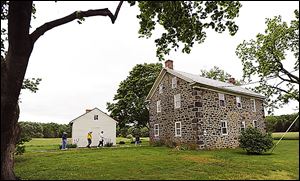
150 years ago, history at a crossroads
Gettysburg is not so much a Pennsylvania town as an American icon
6/30/2013
In Gettysburg, a tour group visits the historic George Spangler Farm property, which was the site of a field hospital and temporary cemetery during the Civil War battle.
GETTYSBURG — We are met on a great battlefield of the Civil War.
It was here 150 years ago that the war turned. That its conclusion, while not visible, was at least imaginable.
And it was here, four months later, that a 270-word speech transformed the war from a struggle to save the Union to one to save the soul of the country.
Many acts of heroism occurred here, most of them lost to history. Many acts of folly and futility occurred here, one of them (Pickett’s charge) preserved in a thousand histories and in a nation’s collective memory.
Ten remarkable sentences of enduring wisdom were uttered here, memorized by generations of Americans who share the liberty that Abraham Lincoln assured was won here.
Pressed into the soil here were the footfalls of Robert E. Lee, George Meade, and George Pickett; of 50,000 men who would be counted as casualties; of many multiples more who would survive; and, in November, 1863, of Mr. Lincoln himself — making Gettysburg perhaps the only American town of 2,400 people ever to bear witness to the toil of so many figures of such grandeur.
Gettysburg is more than three times bigger than it was a century and a half ago, but it remains one of the few towns of its size that does not require a state to identify its location.
Gettysburg is not so much a Pennsylvania town as an American icon. Like Valley Forge, it belongs to our common history more than to the commonwealth of Pennsylvania. Both are obscure corners of the country sanctified by sacrifice — consecrated, you might say, far above our poor power to add or detract.
But here, even more than at Valley Forge, we feel the terrible toll of the terrible swift sword, the great losses suffered by warriors from both sides when the men abandoned the altars of the evening dews and damps, and slipped quietly into battle, some of them moving silently to their violent deaths.
The beginning of July, 1863, was a peculiar American moment — a time when the destiny of a continent began to be clarified — but it was not an inevitable moment. In his Second Inaugural Address in March, 1865, Mr. Lincoln would note that soldiers and sympathizers of both sides “read the same Bible and pray to the same God, and each invokes His aid against the other.”
Union forces may have come to believe that they moved with God’s gusts at their back, but before Gettysburg the resolution of the war was anything but certain.
Antietam lit the way, and with a Union victory at a creek there the previous September, Mr. Lincoln felt sufficient confidence to contemplate his Emancipation Proclamation.
But Gettysburg may be the better dividing line, and 1863, like 1963 a century later, might be the better benchmark to see a world transformed.
By the dim and flaring lamps of 150 years of perspective we now see that Gettysburg split the Civil War into two parts, before and after, much like the war split the country in two, setting state against state and sometimes brother against brother.
The importance of Gettysburg was evident instantly. In his diary, New York lawyer George Templeton Strong recognized that the battle removed Philadelphia, Washington, and Baltimore from danger of raids, or perhaps even occupation, by Confederate forces. It ended the cult of invincibility that Union soldiers had built up around their rival, Robert E. Lee.
The America that would emerge out of the Civil War would be riven by the tensions produced by an industrializing nation struggling to reach its economic potential, redeem its political promises, rebuild its ravaged countryside, and heal its deep emotional wounds, all at the same time.
It was in this period that the Dostoyevsky brothers published Alexander Ostrovsky’s play Sin and Sorrow Are Common to All, which provides the leitmotif for the year, a year in which the soldiers of Gettysburg died to make men free and in which a country lawyer, while dedicating and consecrating the cemetery at Gettysburg, gave his country a new birth of freedom.
David Shribman is executive editor of the Pittsburgh Post-Gazette.
Contact him at: dshribman@post-gazette.com